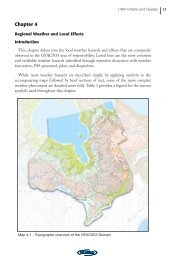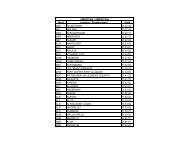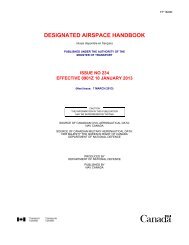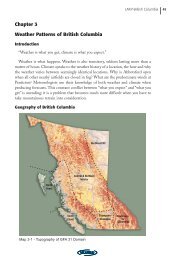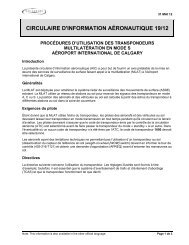The Air Navigation System Plan - Nav Canada
The Air Navigation System Plan - Nav Canada
The Air Navigation System Plan - Nav Canada
You also want an ePaper? Increase the reach of your titles
YUMPU automatically turns print PDFs into web optimized ePapers that Google loves.
A p r i l 2 0 1 2<br />
CHARTING<br />
THE FUTURE<br />
<strong>The</strong> <strong>Air</strong><br />
<strong><strong>Nav</strong>igation</strong><br />
<strong>System</strong> <strong>Plan</strong><br />
AIR NAVIGATION SYSTEM PLAN 2012
Contents<br />
Introduction ...............................................................................1<br />
Performance Based <strong><strong>Nav</strong>igation</strong> (PBN) .......................... 2<br />
Communications ......................................................................5<br />
Surveillance ...............................................................................8<br />
<strong>Air</strong> Traffic Management (ATM) ..................................... 11<br />
Aeronautical Information Management (AIM) ...........14<br />
Aviation Weather .................................................................17<br />
Appendix A: ICAO Aviation <strong>System</strong> Block Upgrades<br />
Summary Table .....................................................................20<br />
AIR NAVIGATION SYSTEM PLAN 2012<br />
Foreword<br />
NAV CANADA is the private sector, non-share<br />
capital corporation that owns and operates<br />
<strong>Canada</strong>’s civil air navigation system. We<br />
coordinate the safe and efficient movement of aircraft<br />
in Canadian domestic airspace and in international<br />
airspace assigned to Canadian control. Through our<br />
operations, NAV CANADA delivers air traffic control,<br />
flight information, weather briefings, aeronautical<br />
information, airport advisory services and electronic<br />
aids to navigation.<br />
Charting the Future: <strong>The</strong> <strong>Air</strong> <strong><strong>Nav</strong>igation</strong> <strong>System</strong> <strong>Plan</strong><br />
describes NAV CANADA’s projected plans for future<br />
ANS system development. Our overarching goal is<br />
to continue modernizing the ANS to meet customer<br />
needs, while also recognizing customer resource<br />
constraints. Our vision for this document is in keeping<br />
with the requirements of our core business – to<br />
manage and operate the ANS in a safe, efficient and<br />
cost effective manner.<br />
While the primary focus of the ANS <strong>Plan</strong> is on the<br />
short-term (the next three years) our planning horizon<br />
extends to the near-term (2015 to 2019).<br />
We recognize that the ANS <strong>Plan</strong> does not exist in<br />
a vacuum. As readers will note, the contents are<br />
inextricably linked to global harmonization activities of<br />
the International Civil Aviation Organization (ICAO). In<br />
addition, the initiatives noted herein are closely aligned<br />
with internal strategic planning processes within<br />
NAV CANADA.<br />
Finally, it is important to note that this plan is meant to<br />
be a collaborative and ‘living’ document, with updates<br />
occurring every three years. Consequently, input from<br />
the aviation community is key to ensuring the plan is<br />
aligned with the day-to-day business realities, and the<br />
technology and service delivery plans, of our customers<br />
and stakeholders. As such, we welcome any and all<br />
comments on the content to follow.<br />
John W. Crichton<br />
President and Chief Executive Officer
Introduction<br />
<strong>The</strong> <strong>Air</strong> <strong><strong>Nav</strong>igation</strong> <strong>System</strong> (ANS) <strong>Plan</strong> describes<br />
NAV CANADA’s short-term and near-term<br />
initiatives aimed at meeting customers’<br />
requirements. It provides an outlook to generate<br />
discussion among customers, staff and other<br />
stakeholders, with the goal of choosing the most<br />
beneficial path to the ANS of the future. NAV CANADA<br />
will continue to communicate and collaborate with<br />
customers through this plan and other documents such<br />
as Direct Route and web sites such as OnBoard<br />
(www.onboard-abord.ca).<br />
STRUCTURE<br />
<strong>The</strong> ANS <strong>Plan</strong> is organized into the following sections:<br />
• Performance Based <strong><strong>Nav</strong>igation</strong> (PBN)<br />
• Communications<br />
• Surveillance<br />
• <strong>Air</strong> Traffic Management (ATM)<br />
• Aeronautical Information Management (AIM)<br />
• Aviation Weather<br />
TIMEFRAMES<br />
<strong>The</strong> content in each section is presented in two<br />
timeframes in calendar years:<br />
• Short-Term 2012 - 2014<br />
• Near-Term 2015 - 2019<br />
CONTENT<br />
<strong>The</strong> content of each section is supported by<br />
supplementary information contained in text boxes, a<br />
timeframe graph with callout boxes highlighting key<br />
milestones and an acronym table.<br />
MAPPING TO ICAO AVIATION SYSTEM BLOCK<br />
UPGRADES<br />
NAV CANADA initiatives in the ANS <strong>Plan</strong> are mapped<br />
to the ICAO Aviation <strong>System</strong> Block Upgrades. This links<br />
the modernization initiatives of NAV CANADA to the<br />
global harmonization activities of ICAO. In the timeframe<br />
graph, NAV CANADA initiatives in each callout box are<br />
mapped, when applicable, to the summary table of the<br />
ICAO system block upgrades contained in Appendix A<br />
(i.e., B0-10 maps to Block 0 module 10).<br />
UPDATE SCHEDULE<br />
<strong>The</strong> ANS <strong>Plan</strong> will be updated every three years<br />
coinciding with the short-term time frame.<br />
QUESTIONS COMMENTS<br />
To provide comments or for more information on the<br />
ANS <strong>Plan</strong>, please contact NAV CANADA Customer<br />
Service at service@navcanada.ca or 1-800-876-4693.<br />
AIR NAVIGATION SYSTEM PLAN 2012<br />
1
2 PERFORMANCE<br />
BASED NAVIGATION (PBN)<br />
Overview<br />
<strong>The</strong> PBN concept<br />
represents a<br />
shift from sensorbased<br />
to performancebased<br />
navigation. PBN<br />
specifies that aircraft<br />
navigation performance<br />
requirements/<br />
specifications be defined<br />
in terms of accuracy,<br />
PBN provides the basis for<br />
a regulatory framework<br />
that addresses today’s<br />
and tomorrow’s navigation<br />
requirements for safety,<br />
efficiency, capacity,<br />
accessibility and the<br />
environment.<br />
integrity, availability, continuity and functionality, which<br />
are needed for the proposed operations in a particular<br />
airspace. PBN provides a list of navigation specifications<br />
that have applicability to one or more types of<br />
airspace (terminal, en-route, and remote/oceanic)<br />
and is only one of several enablers (Surveillance,<br />
Communications and <strong>Air</strong> Traffic Management) of an<br />
airspace concept. As with all changes to the ANS, PBN<br />
will be implemented, where feasible, based on a positive<br />
business case.<br />
AIR NAVIGATION SYSTEM PLAN 2012<br />
Short-Term 2012 - 2014<br />
Existing PBN<br />
specifications<br />
for instrument<br />
procedures<br />
will be<br />
implemented<br />
in Toronto,<br />
Montreal, Ottawa and Quebec City. RNP 10 will be<br />
implemented in Edmonton North <strong>Air</strong>space (North<br />
of 70N). Terminal airspace redesigns using PBN<br />
concepts will commence adhering to the established<br />
PBN implementation<br />
priorities. Trials<br />
of radius-to-fix<br />
paths in Toronto,<br />
Ottawa, Calgary<br />
and Vancouver<br />
terminal airspace<br />
will determine<br />
priorities for future<br />
application. Based on<br />
aeronautical studies,<br />
selected non-essential<br />
ground-based<br />
NAVAIDS will be<br />
decommissioned.<br />
PBN Implementation Priorities<br />
1. Major Terminal <strong>Air</strong>space<br />
2. Second and Third Level <strong>Air</strong>ports<br />
3. Northern/Remote <strong>Air</strong>space and <strong>Air</strong>ports<br />
4. Targets of Opportunity<br />
Canadian <strong>Air</strong>space is<br />
divided into Northern and<br />
Southern domestic airspace<br />
with further classification<br />
into CMNPS and RNPC.<br />
<strong><strong>Nav</strong>igation</strong> performance<br />
requirements in <strong>Canada</strong><br />
are classified as meeting<br />
either of these unique<br />
Canadian standards.<br />
<strong>The</strong>se designations will be<br />
replaced by PBN <strong><strong>Nav</strong>igation</strong><br />
Specifications.
Near-Term 2015 - 2019<br />
Transition from<br />
a sensor-based<br />
environment to a<br />
PBN environment<br />
will commence as<br />
PBN specifications<br />
are approved for<br />
application. Terminal<br />
airspace redesigns<br />
using PBN concepts<br />
will continue based<br />
on the established<br />
PBN implementation<br />
priorities. <strong>The</strong> low-level<br />
airspace structure<br />
will be redefined, in<br />
GBAS technology currently<br />
supports precision<br />
approach equivalent to ILS<br />
Cat I. ICAO is developing<br />
the necessary SARPs to<br />
support equivalency to ILS<br />
Cat II/III. NAV CANADA will<br />
investigate the technical<br />
and financial feasibility of<br />
Cat I GBAS in the nearterm<br />
and monitor the<br />
development of Cat II/III.<br />
concert with surveillance strategies, to incorporate<br />
PBN concepts. <strong>The</strong> decommissioning of selected nonessential<br />
ground-based NAVAIDS will continue when<br />
supported by aeronautical studies. Additional RNAV and<br />
RNP procedures will be implemented following <strong>Air</strong>port/<br />
Terminal airspace reviews, aeronautical studies and AIS<br />
reviews of existing procedures.<br />
NAV CANADA will continue the transition to a PBN<br />
environment with ground-based navigation aids<br />
providing only a back-up capability. It is envisaged that<br />
4D TBOs will exist in the long-term supporting the<br />
transition to full gate-to-gate management. Terminal<br />
airspace redesigns will consider future technologies<br />
and design an airspace system that is flexible enough to<br />
be able to adjust for future TBOs with minimal effort.<br />
Implementation of PBN in <strong>Canada</strong> is seen as<br />
an ongoing series of qualification upgrades to<br />
aircraft, crew and ATM. PBN specifications will<br />
be implemented based on the development of<br />
viable business cases that will consider customer<br />
equipage, ICAO PBN standards, and the applicability<br />
of the specification to the airspace. Consequently,<br />
not all specifications will be applied in <strong>Canada</strong>.<br />
PERFORMANCE BASED NAVIGATION (PBN)<br />
Approximate northern limit of 99% WAAS LPV coverage.<br />
AIR NAVIGATION SYSTEM PLAN 2012<br />
3
4<br />
PBN Timeframe<br />
PERFORMANCE BASED NAVIGATION (PBN)<br />
Implementation will be based on priorities that are cognizant of regulations (current and future) as well as customer requirements<br />
and capabilities. <strong>The</strong> requirement is for a total system capability to enable an air operation and, therefore, implementation will be<br />
aligned with advancements in communications (DCPC, CPDLC), surveillance (ADS-B, WAM) and <strong>Air</strong> Traffic Management. PBN<br />
implementation projects, including WTM and AASP, will need to meet stakeholder requirements and a viable business case.<br />
NAV CANADA<br />
capable of<br />
designing RNP<br />
procedures<br />
B0-65*<br />
WAAS deployed in<br />
2007 and LPV service<br />
available<br />
B0-65*<br />
ILS Replacement<br />
Project completed<br />
with LOC (BC)<br />
procedures replaced<br />
with RNAV<br />
Selected<br />
DND TACANs<br />
replaced with DMEs<br />
RF legs<br />
incorporated<br />
into STARS<br />
B0-05*<br />
B0-10*<br />
B0-65*<br />
PBN<br />
GBAS<br />
WAAS<br />
ILS<br />
DME<br />
NDB<br />
VOR<br />
Conduct GBAS<br />
evaluations<br />
B0-65*<br />
RNP AR<br />
procedures<br />
introduced<br />
B0-65*<br />
AIR NAVIGATION SYSTEM PLAN 2012<br />
CMNPS and RNPC<br />
airspace converted to<br />
PBN specifications<br />
B0-05*<br />
B0-10*<br />
B0-65*<br />
SHORT-TERM<br />
NEAR-TERM<br />
2012 2013 2014 2015 – 2019<br />
<strong>The</strong> application of PBN tools<br />
NDB drawdown<br />
completed<br />
Note: * See explanation of mapping to ICAO Aviation <strong>System</strong> Block Upgrades on page 1.<br />
NAV CANADA supports<br />
the extension of<br />
the US WAAS into<br />
Canadian airspace<br />
to approximately 70<br />
degrees north. This<br />
service supports our<br />
application of LPV<br />
approaches and further<br />
work in the short-term is<br />
expected to result in the<br />
ability to conduct LPV<br />
approaches to a 200<br />
foot DA. WAAS supports<br />
high integrity positioning<br />
supporting RNP and<br />
surveillance applications.<br />
Acronym Table<br />
AASP Alberta <strong>Air</strong>space and Services<br />
Project<br />
ADS-B Automatic Dependent<br />
Surveillance -Broadcast<br />
AIS Aeronautical Information<br />
Services<br />
CCO Continuous Climb Operations<br />
CDO Continuous Descent Operations<br />
CMNPS Canadian Minimum <strong><strong>Nav</strong>igation</strong><br />
Performance Specifications<br />
CPDLC Controller-Pilot Data Link<br />
Communications<br />
DA Decision Altitude<br />
DME Distance Measuring Equipment<br />
DCPC Direct Controller-Pilot<br />
Communications<br />
GBAS Ground Based Augmentation<br />
<strong>System</strong><br />
ILS Instrument Landing <strong>System</strong><br />
LNAV Lateral <strong><strong>Nav</strong>igation</strong><br />
LOC(BC) Localizer (Back Course)<br />
LOS Level of Service<br />
LPV Localizer Performance with<br />
Vertical Guidance<br />
NDB Non-Directional Beacon<br />
RF Radius to Fix<br />
RNAV Area <strong><strong>Nav</strong>igation</strong><br />
RNP Required <strong><strong>Nav</strong>igation</strong><br />
Performance<br />
RNP AR Required <strong><strong>Nav</strong>igation</strong><br />
Performance<br />
Authorization Required<br />
RNPC Required <strong><strong>Nav</strong>igation</strong><br />
Performance Capability<br />
SARPs Satndards and Recommended<br />
Practices<br />
VOR drawdown<br />
completed<br />
Low Level airspace<br />
restructuring<br />
opportunities<br />
B0-10*<br />
<strong>The</strong> PBN<br />
TOOLBOX<br />
RNP<br />
RNAV<br />
LPV<br />
VNAV<br />
LNAV<br />
GBAS<br />
SBAS<br />
CDO<br />
CCO<br />
SIDS<br />
STARS<br />
SBAS* Satellite Based Augmentation<br />
<strong>System</strong><br />
SIDS Standard Instrument Departures<br />
STARS Standard Arrival Routes<br />
TBOs Trajectory-Based Operations<br />
VNAV Vertical <strong><strong>Nav</strong>igation</strong><br />
VOR Very high frequency<br />
Omnidirectional Range<br />
WAAS* Wide Area Augmentation<br />
<strong>System</strong><br />
WAM Wide Area Multilateration<br />
WTM Windsor/Toronto/Montreal<br />
<strong>Air</strong>space and Services Review<br />
* WAAS is the North American version of the<br />
generic SBAS
Overview<br />
Communication is an integral element of<br />
navigation, surveillance and ATM initiatives.<br />
<strong>The</strong>re will be a significant increase in the use of<br />
data link with the benefit of high speed, high integrity<br />
data transfers and reduced frequency congestion<br />
and improved message clarity. <strong>The</strong> use of UHF and<br />
HF voice communications will decline, however voice<br />
communications, primarily digital and analog VHF, will<br />
remain an efficient method of achieving DCPC. <strong>The</strong><br />
NAV CANADA air-to-ground communications strategy<br />
does not currently include HFDL. <strong>The</strong> use of CPDLC is<br />
expanding from oceanic and remote applications to the<br />
domestic environment.<br />
Short-Term<br />
2012 - 2014<br />
<strong>The</strong> RCO redesign<br />
program will be<br />
completed. In<br />
consultation with<br />
customers, UHF<br />
services will be<br />
reduced while<br />
retaining the<br />
required<br />
coverage.<br />
<strong>The</strong> FIC RCO system is being<br />
redesigned to resolve frequency<br />
congestion and interference<br />
problems. Four FISE frequencies<br />
will be deployed at RCO sites<br />
to ensure minimum frequency<br />
overlap with one of the four<br />
frequencies strategically sited for<br />
optimum use above FL 180. This<br />
redesign will improve FISE and<br />
support IFR operations.<br />
<strong>The</strong> VHF radio<br />
replacement program<br />
will continue the<br />
replacement of over<br />
2,000 radio pairs.<br />
SATCOM voice will be<br />
used as an alternate<br />
communication link<br />
when preferred and<br />
when an aircraft is<br />
out of the coverage<br />
area of ground-based<br />
communications.<br />
CPDLC will be<br />
implemented in the<br />
domestic enroute<br />
environment. PDC will<br />
be implemented at<br />
COMMUNICATIONS<br />
PDC is a system that<br />
provides IFR departure<br />
clearance via data link<br />
to subscribing airlines at<br />
selected airports.<br />
NAV CANADA PDC currently<br />
uses the 620/622<br />
communications protocol,<br />
with service currently limited<br />
to ARINC data link service<br />
subscribers. At major<br />
airports, NAV CANADA<br />
will be introducing the PDC<br />
623 protocol, which will be<br />
available to subscribers of<br />
both ARINC and SITA.<br />
major airports. AIDC implementation will be pursued.<br />
ADS-C capability for use in domestic airspace will be<br />
researched.<br />
AIR NAVIGATION SYSTEM PLAN 2012<br />
5
6<br />
COMMUNICATIONS<br />
<strong>The</strong> eight year NAV CANADA VHF radio<br />
replacement program will be completed in 2016.<br />
Over 2,000 VHF radio pairs, fully compatible with<br />
all current and planned future analog and digital<br />
voice and text message formats, will be installed at<br />
some 320 sites across the country. All radios will<br />
be capable of future international standards either<br />
VDL digital communications or 8.33 kHz spacing.<br />
<strong>The</strong> radios will be configured for 25 kHz frequency<br />
spacing, matching current frequency assignments in<br />
<strong>Canada</strong> and the USA.<br />
Near-Term 2015 - 2019<br />
<strong>The</strong> VHF radio replacement program, including the<br />
new telecom infrastructure, will be completed. HF<br />
voice will migrate to a backup service for VHF and<br />
data link. AMHS will be implemented and AFTN will be<br />
decommissioned. ADS-C will replace AFTN waypoint<br />
reporting.<br />
HF voice will be solely retained as a backup to VHF<br />
and data link. All radios will be capable of VDL digital<br />
communications or 8.33 kHz channel spacing.<br />
AIR NAVIGATION SYSTEM PLAN 2012<br />
NAV CANADA will continue to modernize the<br />
telecommunications structure to accommodate<br />
future technology advances and associated customer<br />
requirements.<br />
SATCOM includes SATCOM Voice and SATCOM<br />
Data. SATCOM Data is already being used in the<br />
Pacific and NAT Regions and will soon be utilised in<br />
the Polar Region. SATCOM is being used globally,<br />
primarily outside VHF coverage. <strong>The</strong> use of SATCOM<br />
Voice to supplement data link is being evaluated.<br />
AMHS is a modern electronic messaging system<br />
used to transfer and deliver ground to ground<br />
data such as flight plans, NOTAM and weather<br />
information amongst the members of the global<br />
air traffic control community. It is a replacement<br />
technology for the AFTN which is now technically<br />
obsolete.
Communications Timeframe<br />
AIDC<br />
Edmonton/Anchorage<br />
implemented<br />
B0-25*<br />
AIDC<br />
Edmonton/Reykjavik<br />
Implemented<br />
B0-25*<br />
AIDC<br />
Gander/New York<br />
implemented<br />
B0-25*<br />
CPDLC implemented<br />
Montreal and Edmonton<br />
ACCs<br />
B0-40*<br />
CPDLC expanded<br />
to Vancouver, Winnipeg,<br />
Moncton and Gander<br />
(domestic) ACCs<br />
B0-40*<br />
PDC 620/622<br />
implemented<br />
81 RCO sites<br />
redesigned<br />
B1-105*<br />
140 RCO sites<br />
redesigned<br />
project completed<br />
B1-105*<br />
Research ADS-C<br />
use in domestic<br />
airspace<br />
ADS-C<br />
AFTN<br />
AIDC<br />
AMHS<br />
CPDLC<br />
HF Voice<br />
HFDL<br />
PDC<br />
RCO<br />
SATCOM Data<br />
SATCOM Voice<br />
UHF Voice<br />
VDL<br />
VHF Voice<br />
SATCOM Data<br />
implemented in<br />
the Polar Region<br />
B0-40*<br />
VHF radio<br />
replacement<br />
program continues<br />
UHF services<br />
reduced<br />
PDC 623<br />
implementation<br />
at major airports<br />
AIDC<br />
Vancouver/Oakland<br />
Implemented<br />
B0-25*<br />
SHORT-TERM<br />
NEAR-TERM<br />
2012 2013 2014 2015 – 2019<br />
Note: * See explanation of mapping to ICAO Aviation <strong>System</strong> Block Upgrades on page 1.<br />
Acronym Table<br />
ADS-C Automatic Dependent Surveillance –<br />
Contract<br />
AFTN Aeronautical Fixed Telecommunications<br />
Network<br />
AIDC ATS Interfacility Data Communication<br />
AMHS <strong>Air</strong> Traffic Services Message Handling<br />
<strong>System</strong><br />
COMMUNICATIONS<br />
SATCOM Voice used<br />
outside ground based<br />
VHF coverage<br />
VHF radio<br />
replacement<br />
program completed<br />
Moving towards<br />
greater use of VDL<br />
B0-40*<br />
Moving towards<br />
8.33 kHz<br />
channel spacing<br />
ATM <strong>Air</strong> Traffic Management<br />
CPDLC Controller Pilot Data Link Communications<br />
DCPC Direct Controller Pilot Communications<br />
FIC Flight Information Centre<br />
FISE Flight Information Service Enroute<br />
HF High Frequency<br />
HFDL High Frequency Data Link<br />
CPDLC expanded<br />
to Toronto<br />
B0-40*<br />
AIR NAVIGATION SYSTEM PLAN 2012<br />
7<br />
ADS-C replaces<br />
AFTN WPR<br />
B0-35*<br />
AFTN<br />
decommissioned<br />
Trans-border<br />
AIDC implemented<br />
with FAA<br />
B0-25*<br />
AMHS<br />
implemented<br />
B0-25<br />
HF voice solely<br />
retained as backup<br />
to VHF and data link<br />
HF voice migrates<br />
to backup for VHF<br />
and data link<br />
B0-40*<br />
While HFDL is not part<br />
of the primary communications<br />
strategy, it is a<br />
consideration in the move<br />
to data link. Transmitting data<br />
over HF and the<br />
performance of HFDL<br />
are being reviewed to<br />
determine future<br />
applications<br />
PDC Pre-departure Clearance<br />
RCO Remote Communications Outlet<br />
SATCOM Satellite Communications<br />
UHF Ultra High Frequency<br />
VDL Very High Frequency Data Link<br />
VHF Very High Frequency<br />
WPR Waypoint Reporting
8<br />
SURVEILLANCE<br />
Overview<br />
ATC surveillance<br />
systems enable<br />
air traffic controllers to<br />
provide a safe, efficient and<br />
orderly movement of air<br />
traffic, both in the air and<br />
on the ground. Surveillance<br />
provides situational<br />
awareness to enable the<br />
application of reduced<br />
aircraft separation minima<br />
Continuous air<br />
traffic surveillance<br />
enhances safety,<br />
reduces aircraft<br />
separation minima,<br />
increases airspace<br />
capacity and enables<br />
improved flight profile<br />
efficiencies.<br />
as compared to those required for procedural control.<br />
Today’s surveillance technology includes Primary and<br />
Secondary Radar, <strong>Air</strong>port Surface Detection Equipment,<br />
Automatic Dependent Surveillance-Broadcast,<br />
<strong>The</strong> three classes of surveillance are:<br />
• Independent Non-Cooperative Surveillance which<br />
includes PSR and ASDE.<br />
• Independent Cooperative Surveillance which includes<br />
SSR and MLAT.<br />
• Dependent Cooperative Surveillance which includes<br />
ADS-B.<br />
<strong>The</strong>re is a transition underway from independent to<br />
dependent surveillance.<br />
AIR NAVIGATION SYSTEM PLAN 2012<br />
Multilateration and video sensors, as well as related<br />
surveillance fusion processing. Surveillance systems<br />
are used in the enroute, terminal and airport service<br />
(ground) environments. Over the years, deployment of<br />
seven Northern Radars, ADS-B (Hudson Bay, Northeast<br />
Coast/Baffin Island and Greenland) and Multilateration<br />
as well as access to the FAA radar surveillance<br />
and DND North Warning Radar <strong>System</strong> data have<br />
collectively been useful in closing gaps in coverage.<br />
Short-Term 2012 - 2014<br />
A review of current radar capability will be conducted to<br />
assess the requirement for PSR. Expanded deployment<br />
of WAM and airport<br />
MLAT systems will<br />
occur based on a<br />
positive business case.<br />
Specifically, WAM<br />
for Kelowna will be<br />
deployed in early 2012.<br />
MLAT airport surface<br />
surveillance will be<br />
deployed at Calgary<br />
International and<br />
Toronto International<br />
airports. Video<br />
surveillance will be<br />
ADS-B equipped aircraft<br />
transmit their position,<br />
derived from the GNSS,<br />
automatically via data<br />
link. ADS-B broadcasts<br />
are received by ground<br />
stations and routed to<br />
ATC facilities for use in<br />
ATM. ADS-B transmissions<br />
contain a large quantity<br />
of information including<br />
aircraft position, altitude,<br />
speed and trajectory.
implemented as stand alone ASDE and as part of<br />
existing systems. Surveillance processing systems<br />
will be upgraded to employ fusion tracking technology<br />
through both airport-specific (surface A-SMGCS) and<br />
regional (air fusion) programs.<br />
Fusion combines data from multiple sources so that<br />
the resultant information for use in the provision<br />
of ANS services is more accurate, consistent<br />
and timely. Fusion takes on a number of forms.<br />
Fusing data for ATC display is one form utilized<br />
in ATM display systems. In the case of A-SMGCS<br />
and surveillance fusion systems, surveillance<br />
data, including aircraft-derived, ground-based and<br />
safety alert information, is fused enhancing airport<br />
and gate-to-gate traffic management services<br />
respectively.<br />
Near-Term 2015 - 2019<br />
For this timeframe, replacement of specific radars will<br />
be undertaken for the major airports and their backup<br />
sites. Remote high-level surveillance gaps, including<br />
the southeast coast of <strong>Canada</strong>, oil platforms in the<br />
Atlantic, Yukon Territory bordering Alaskan airspace<br />
and the balance of the Arctic airspace, will be assessed<br />
and recommendations made based on the business<br />
case analysis. In addition, surveillance coverage in<br />
Southern <strong>Canada</strong> will be expanded using WAM, at<br />
specific locations to improve operations and where<br />
supported by business and safety cases. Performancebased<br />
traffic management safety and efficiency benefits<br />
(see ATM section) will accrue from the deployment of<br />
fusion technologies. <strong>The</strong>se technologies will provide<br />
gate-to-gate as well as central/national capabilities.<br />
Consideration will be given to replacing existing ASDE<br />
and providing additional ground surveillance at new<br />
airports with ADS-B, MLAT and/or video.<br />
It is envisaged that both radar and WAM will be<br />
assessed for<br />
conversion to ADS-B<br />
surveillance provided<br />
customer ADS-B<br />
equipage reaches an<br />
acceptable level. In<br />
addition, NAV CANADA<br />
will investigate<br />
expanding surveillance<br />
in the North Atlantic<br />
using low earth orbit<br />
satellites.<br />
SURVEILLANCE<br />
MLAT is a method of<br />
position sensing using<br />
at least three receivers.<br />
<strong>The</strong> location of an aircraft<br />
or vehicle is determined<br />
by performing a time<br />
difference of arrival analysis<br />
on signals from vehicle and<br />
aircraft transponders.<br />
AIR NAVIGATION SYSTEM PLAN 2012<br />
9
10<br />
Current TSR <strong>Air</strong>ports<br />
1 Toronto - Major<br />
2 Vancouver - Major<br />
3 Calgary - Major<br />
4 Montreal - Major<br />
5 Ottawa<br />
6 Winnipeg<br />
7 Edmonton<br />
8 Quebec<br />
9 Victoria<br />
10 Moncton<br />
11 Halifax<br />
SURVEILLANCE<br />
Surveillance Timeframe<br />
Evaluate WAM<br />
as a SSR<br />
replacement<br />
Oceanic<br />
ADS-B<br />
implemented<br />
B0-86*<br />
Based on a<br />
business case<br />
supported strategy<br />
implement MLAT<br />
at approved sites<br />
B0-75*<br />
Evaluate MLAT and<br />
Video as an A-SMGCS<br />
replacement<br />
B0-75*<br />
Based on a business<br />
case supported<br />
strategy implement<br />
WAM<br />
expansion projects<br />
B0-85*<br />
Conduct<br />
aeronautical study<br />
of PSR<br />
requirements<br />
PSR<br />
SSR<br />
ADS-B<br />
MLAT<br />
WAM<br />
VIDEO<br />
ASDE<br />
SFS<br />
Expanded<br />
deployment of<br />
A-SMGCS for<br />
airport surveillance<br />
B0-75*<br />
12 London<br />
13 Saskatoon<br />
14 Thunder Bay<br />
15 Regina<br />
16 St. John’s<br />
17 Hamilton<br />
18 Prince George<br />
19 Sault Ste Marie<br />
20 North Bay<br />
21 Gander<br />
22 Mirabel<br />
AIR NAVIGATION SYSTEM PLAN 2012<br />
Expand surface<br />
surveillance coverage<br />
with MLAT<br />
B0-75*<br />
SHORT-TERM<br />
NEAR-TERM<br />
2012 2013 2014 2015 – 2019<br />
Deploy Enroute<br />
/Terminal SFS<br />
upgrades<br />
B0-85*<br />
SFS separation<br />
optimization<br />
B0-85*<br />
SFS safety<br />
net additions<br />
B0-85*<br />
Note: * See explanation of mapping to ICAO Aviation <strong>System</strong> Block Upgrades on page 1.<br />
Acronym Table<br />
Based on evaluation<br />
implement strategy<br />
for replacement of<br />
SSRs with WAM<br />
Gate-to-gate SFS<br />
integration<br />
and national<br />
capabilities<br />
B0-85*<br />
ADS-B Automatic Dependent Surveillance-Broadcast<br />
ADS-C Automatic Dependent Surveillance-Contract<br />
ASDE <strong>Air</strong>port Surface Detection Equipment<br />
A-SMGCS Advanced Surface Movement Guidance and Control <strong>System</strong><br />
ATS <strong>Air</strong> Traffic Services<br />
DCPC Direct Controller-Pilot Communications<br />
DND Canadian Department of National Defence<br />
FAA USA Federal Aviation Administration<br />
GNSS Global <strong><strong>Nav</strong>igation</strong> Satellite <strong>System</strong><br />
MLAT Multilateration<br />
PSR Primary Surveillance Radar<br />
SFS Surveillance Fusion <strong>System</strong><br />
SSR Secondary Surveillance Radar<br />
TSR Terminal Surveillance Radar<br />
WAM Wide Area Multilateration<br />
New PSR systems<br />
installed at<br />
Toronto, Vancouver,<br />
Calgary and Montreal<br />
Based on a<br />
business case<br />
supported strategy<br />
fill high-level<br />
surveillance gaps<br />
with ADS-B<br />
B0-86*<br />
Expand airborne<br />
surveillance<br />
coverage with WAM<br />
B0-85*<br />
ASDE replaced<br />
with MLAT/video<br />
B0-75*<br />
SFS gate-to-gate<br />
(surface/air)<br />
integration<br />
B0-10*<br />
B0-15*<br />
B0-85*
Overview<br />
the integrated management of air<br />
ATM, traffic and airspace, will be achieved<br />
safely, economically and efficiently to meet current and<br />
future customer requirements. <strong>The</strong> ATM system must<br />
provide collaborative, seamless services supported<br />
by communications, navigation and surveillance in a<br />
system-wide environment that generates and manages<br />
information through the use of technology. <strong>System</strong>s<br />
will be incrementally enhanced to support increasingly<br />
performance-based services.<br />
Short-Term 2012 - 2014<br />
SARA provides speed and<br />
route advisories to assist in<br />
ensuring an aircraft’s time<br />
over a meter fix at a time<br />
provided by SASS.<br />
Implement CFPS<br />
interface with CAATS in<br />
2012 allowing webbased<br />
IFR flight<br />
planning to be fully<br />
integrated into ATM<br />
systems. Implement<br />
CFPS integrated weather and NOTAM functionality in<br />
2013 allowing web-based flight plan centric pilot<br />
briefings. Implement mobile app for CFPS flight plan filing<br />
by 2013. Implement ICAO compliant data exchange<br />
interface, WXXM, for weather data exchange between<br />
CFPS and internal and third party systems. Implement<br />
FP 2012. Implement initial SARA at Toronto airport and<br />
conduct individual business cases to determine if<br />
11<br />
AIR TRAFFIC MANAGEMENT (ATM)<br />
expansion is<br />
warranted. Decision<br />
support tools such as<br />
MTCD and VWF will be<br />
implemented.<br />
Implement FSS<br />
modernization at all<br />
FSS. Implement<br />
changes to GAATS+<br />
and coordinate with<br />
other agencies to<br />
facilitate the implementation of RLatSM Phase 1.<br />
A CONOPS for the implementation of RLatSM Phases 2<br />
and 3 will be developed. As supported by trial outcomes<br />
and a sound business case, with the appropriate<br />
RLongSM has<br />
been in trial in<br />
the NAT since<br />
March 2011.<br />
<strong>The</strong> FSS modernization<br />
project aims to deliver a<br />
family of NAV CANADA<br />
developed Tower and<br />
FSS products to all Flight<br />
Service Stations in <strong>Canada</strong>.<br />
Configuration will include<br />
many standard IIDS<br />
applications.<br />
approvals, RLongSM will be<br />
implemented in the NAT and<br />
Canadian domestic airspace.<br />
Working with industry, Transport<br />
<strong>Canada</strong> and ICAO advance the<br />
integration of RPA into the ANS.<br />
AIR NAVIGATION SYSTEM PLAN 2012
12<br />
AIR TRAFFIC MANAGEMENT (ATM)<br />
Near-Term 2015 - 2019<br />
Implement ICAO<br />
compliant data<br />
exchange interface, for<br />
flight data exchange<br />
between CFPS and<br />
internal and third party<br />
systems. If supported<br />
by Phase 1 trial<br />
outcomes and a<br />
business case, RLatSM<br />
Phase 2 will be<br />
implemented in the<br />
NAT. Based on a<br />
Advances in ATS standards<br />
and procedures, such as<br />
ADS-B in-trail procedures,<br />
improved separation<br />
standards for crossing/<br />
merging tracks, climb/<br />
descent separation and<br />
fusion tracks, will continue<br />
to be explored and<br />
implemented as warranted.<br />
business case supported strategy the deployment of<br />
SARA and other advanced decision support tools will be<br />
expanded. Advance the capability and functionality of<br />
CAATS, SFS and GAATS+ as warranted. In concert with<br />
NextGen and SESAR, the concepts of FF-ICE will be<br />
researched and implemented when advancements to<br />
interoperability, efficiency and capacity can be effectively<br />
achieved. <strong>The</strong> integration of RPA into the ANS will<br />
continue.<br />
AIR NAVIGATION SYSTEM PLAN 2012<br />
RLatSM Implementation Phases<br />
Phase 1 [2015] 25 NM lateral separation ½ degree spacing<br />
between 2 core tracks, within vertical limits of<br />
NAT Data Link Mandated airspace<br />
Phase 2 [2017] 25 NM lateral separation ½ degree spacing<br />
through the entire NAT OTS, within vertical<br />
limits of NAT Data Link Mandated airspace<br />
Phase 3 [2020] 25 NM lateral separation ½ degree spacing<br />
through the entire NAT Region, including<br />
converging and intersecting tracks, within<br />
vertical limits of NAT Data Link Mandated<br />
airspace<br />
Separation optimizations and related safety net<br />
improvements (e.g. Approach Path Monitoring, <strong>Air</strong>-<br />
Ground Conformance) will be implemented through<br />
incremental deployment of data fusion technologies.<br />
It is envisaged that advances<br />
in ATFM, including dynamic<br />
ATS routing, system wide flow<br />
management, and interval<br />
management will result in a<br />
RLatSM Requirements<br />
1. RNP4 operations<br />
2. ADS-C position reports<br />
3. CPDLC established<br />
balancing of demand with capacity. If supported by a<br />
comprehensive business case, Phase 3 of the RLatSM<br />
will be implemented in the NAT. <strong>The</strong> concept of FF-ICE<br />
will continue to be pursued.
ATM Timeframe<br />
CAATS<br />
implemented nationally<br />
with ongoing LCM<br />
FP 2012<br />
implemented<br />
BO-25*<br />
NAVCANsuite<br />
installed at<br />
Mirabel FSS<br />
B0-30*<br />
GAATS+ integrated<br />
with ADS-B<br />
B0-86*<br />
SASS integration<br />
with CAATS<br />
B0-15*<br />
AWF, CA, CoPr,<br />
CRDA and MSAW<br />
in use<br />
B0-15*<br />
B0-30*<br />
MTCD upgrades<br />
B0-35*<br />
B0-85*<br />
CAATS<br />
CFPS<br />
FP 2012<br />
FSS<br />
GAATS+<br />
SASS<br />
RLongSM<br />
RLatSM<br />
DST<br />
13<br />
AIR TRAFFIC MANAGEMENT (ATM)<br />
CFPS Interface<br />
with CAATS deployed<br />
B0-30*<br />
B0-25*<br />
SHORT-TERM<br />
NEAR-TERM<br />
2012 2013 2014 2015 – 2019<br />
Develop a CONOPS<br />
for RLatSM phases<br />
2 and 3<br />
B0-10*<br />
MTCD<br />
implemented<br />
B0-35*<br />
SARA<br />
implemented<br />
at Toronto<br />
B0-35*<br />
B0-15*<br />
VWF<br />
implemented<br />
B0-70<br />
Note: * See explanation of mapping to ICAO Aviation <strong>System</strong> Block Upgrades on page 1.<br />
Acronym Table<br />
AFTN Aeronautical Fixed Telecommunications<br />
Network<br />
ATFM <strong>Air</strong> Traffic Flow Management<br />
AWF <strong>Air</strong>space Warning Feature<br />
CA Conflict Alert<br />
CAATS Canadian Automated <strong>Air</strong> Traffic <strong>System</strong><br />
CFPS Collaborative Flight <strong>Plan</strong>ning <strong>System</strong><br />
CONOPS Concept of Operations<br />
CoPr Conflict Prediction<br />
CRDA Converging Runway Display Aid<br />
DST Decision Support Tools<br />
EXCDS Extended Computer Display <strong>System</strong><br />
FF-ICE Flight and Flow Information for a<br />
Collaborative Environment<br />
FIC Flight Information Centre<br />
FP 2012 Flight <strong>Plan</strong> 2012<br />
FSS Flight Service Station Modernization<br />
GAATS+ Gander Automated <strong>Air</strong> Traffic <strong>System</strong><br />
IIDS Integrated Information Display <strong>System</strong><br />
LCM Life Cycle Management<br />
MSAW Minimum Safe Altitude Warning<br />
MTCD Medium Term Conflict Detection<br />
NARDS NAV CANADA Auxiliary Radar<br />
Display <strong>System</strong><br />
NAT North Atlantic<br />
NextGen Unites States’ Next Generation <strong>Air</strong><br />
Transportation <strong>System</strong><br />
OIDS Operational Information Display <strong>System</strong><br />
CFPS implemented<br />
B0-30*<br />
B0-25*<br />
Based on trial<br />
outcomes<br />
and appropriate<br />
approvals,<br />
implement RLongSM<br />
in the NAT and<br />
in domestic airspace<br />
B0-10*<br />
AIR NAVIGATION SYSTEM PLAN 2012<br />
ADS-C<br />
upgrades<br />
B0-35*<br />
B0-10*<br />
FSS<br />
modernization<br />
completed<br />
B0-30*<br />
SASS integration<br />
with SARA<br />
B0-15*<br />
Decision<br />
Support Tools<br />
AWF<br />
CA<br />
CoPr<br />
CRDA<br />
MSAW<br />
MTCD<br />
SARA<br />
VWF<br />
Implement Phase 2<br />
RLatSM in NAT<br />
B0-10*<br />
Implement Phase 1<br />
RLatSM trials in NAT<br />
B0-10*<br />
RLatSM Reduced Lateral Separation Minimum<br />
RLongSM Reduced Longitudinal Separation<br />
Minimum<br />
RPA Remotely Piloted <strong>Air</strong>craft<br />
SARA Speed and Route Advisor<br />
SASS Scheduling and Sequencing <strong>System</strong><br />
SESAR Europe’s Single European Sky ATM<br />
Research<br />
SFS Surveillance Fusion <strong>System</strong><br />
VWF Vortex Warning Feature<br />
WPR Waypoint Reporting<br />
WXXM Weather Exchange Model
14<br />
AERONAUTICAL INFORMATION MANAGEMENT (AIM)<br />
Overview<br />
is the integrated management of<br />
AIM aeronautical information services through<br />
the provision and exchange of quality-assured digital<br />
aeronautical data. This provision and exchange of<br />
data ensures the flow of information necessary for<br />
the safety, regularity and efficiency of international<br />
air navigation. NAV CANADA is making data available<br />
to customers in more standardized forms that can<br />
be manipulated for display as products specific to<br />
customers’ requirements. Electronic publications are<br />
now available for download from an e-commerce site<br />
and on portable electronic devices.<br />
Short-Term 2012 - 2014<br />
<strong>The</strong> ICAO<br />
Benefits of ICAO SNOWTAM<br />
specified<br />
Designed to be data driven<br />
content<br />
ICAO standard ensures global recognition<br />
of the AIP<br />
Reporting by runway thirds<br />
including<br />
By definition expires after 24 hours<br />
AIP amendments,<br />
supplements and circulars will be published<br />
in a structured electronic format referred to as the<br />
eAIP. NOTAMJ will be replaced with the ICAO format<br />
SNOWTAM. Automated friction measurement<br />
reporting and an interface for manual and automated<br />
input of RSC reports will be implemented. <strong>The</strong> electronic<br />
AIR NAVIGATION SYSTEM PLAN 2012<br />
<strong>The</strong> eAIP will<br />
replace the<br />
AIRAC and<br />
paper AIP.<br />
publications product line and<br />
agreements with vendors, allowing<br />
Canadian aeronautical data on<br />
portable electronic devices, will be<br />
expanded.
Near-Term 2015 - 2019<br />
Canadian NOTAM<br />
will be converted to<br />
the ICAO format and<br />
standard including<br />
geo-referencing and<br />
grouping in series for<br />
ease of use. Digital<br />
NOTAM will replace<br />
the current free text<br />
message composition<br />
format. eTOD will be<br />
available in a data<br />
modelling framework. <strong>The</strong> process to assess the<br />
impact of all human-made obstacles will be automated.<br />
Aeronautical<br />
Publications will explore<br />
the feasibility of moving<br />
towards distributing<br />
aeronautical<br />
information in<br />
electronic format only,<br />
moving away from<br />
paper publications.<br />
15<br />
AERONAUTICAL INFORMATION MANAGEMENT (AIM)<br />
Digital NOTAM will<br />
integrate aeronautical<br />
data into a comprehensive<br />
data management<br />
system providing more<br />
standardized and<br />
consolidated information<br />
to our customers. This<br />
initiative is aligned with the<br />
ICAO AIS to AIM Roadmap.<br />
<strong>The</strong> automation of the land<br />
use assessment process,<br />
which determines the<br />
impact of human-made<br />
obstacles, such as wind<br />
turbines, on aviation, will<br />
enhance flight safety.<br />
NAV CANADA AIM will provide data-dependent systems<br />
with high-quality, timely aeronautical information in the<br />
form of digital data based on structured databases and<br />
geographic information systems.<br />
eTOD Applications<br />
Aeronautical chart production<br />
Instrument procedure design<br />
Minimum safe altitude warning systems<br />
Ground proximity warning systems<br />
Emergency contingency procedures<br />
Advanced surface movement guidance and control systems<br />
Approach path monitoring<br />
<strong>Air</strong>-ground automated coordination (trajectory based operations)<br />
AIR NAVIGATION SYSTEM PLAN 2012
16 AERONAUTICAL<br />
AIM Timeframe<br />
Manual and automated<br />
interface for RSC<br />
B0-30*<br />
B0-75*<br />
Electronic<br />
publications available<br />
on PEDs<br />
B0-30*<br />
Electronic<br />
publications<br />
available from<br />
eCommerce site<br />
B0-30*<br />
eAIP online<br />
B0-30*<br />
eTOD project<br />
start<br />
B1-31*<br />
NOTAM Series<br />
A Aerodrome/Movement or<br />
Landing Area<br />
B ATC Facilities and Services<br />
C Special Uses <strong>Air</strong>space<br />
D Obstruction<br />
E <strong>Air</strong>space<br />
G GNSS<br />
H Chart Corrections<br />
J Special Notices<br />
M Military Flight Safety<br />
N NAVAID<br />
O Other Aeronautical<br />
Information<br />
P Procedural<br />
S SNOWTAM<br />
V ASHTAM<br />
W Database Corrections<br />
Y Test<br />
Z <strong>Air</strong>way<br />
INFORMATION MANAGEMENT (AIM)<br />
NOTAMJ replaced<br />
with ICAO<br />
SNOWTAM<br />
B0-30*<br />
NOTAM<br />
RSC<br />
ePUBS<br />
eAIP<br />
eTOD<br />
LUS<br />
Acronym Table<br />
SHORT-TERM<br />
AIRAC Aeronautical Information Regulation and Control<br />
eAIP Electronic Aeronautical Information Publication<br />
ePUBS Electronic Publications<br />
eTOD Electronic Terrain and Obstacle Data<br />
LUS Land Use Submission Automation<br />
PED Portable Electronic Device<br />
NOTAM ICAO format NOTAM (Notice to airmen)<br />
NOTAMJ <strong>The</strong> Canadian version of a SNOWTAM<br />
RSC Runway Surface Condition Report<br />
SNOWTAM A NOTAM series addressing snow, ice, slush on<br />
movement areas<br />
AIR NAVIGATION SYSTEM PLAN 2012<br />
NEAR-TERM<br />
2012 2013 2014 2015 – 2019<br />
Electronic<br />
publications product<br />
line expanded<br />
B0-30*<br />
Canadian NOTAM<br />
converted to ICAO<br />
format with<br />
geo-referencing<br />
B0-30*<br />
Aeronautical data<br />
available on PEDs<br />
expanded<br />
B0-30*<br />
Note: * See explanation of mapping to ICAO Aviation <strong>System</strong> Block Upgrades on page 1.<br />
Domestic<br />
NOTAM<br />
decommissioned<br />
Digital NOTAM<br />
Implemented<br />
B1-30*<br />
AIRAC, CFS, WAS<br />
and DAH replaced<br />
by eAIP<br />
B1-30*<br />
eTod available in<br />
a data modelling<br />
framework<br />
B1-31*<br />
Automated process<br />
to assess<br />
human-made<br />
obstacles<br />
B0-30*<br />
Additions, withdrawals and<br />
amendments to published<br />
aeronautical information are<br />
distributed under the regulated<br />
system AIRAC which provides<br />
advance notification of changes<br />
to aeronautical information<br />
based on an established series<br />
of common effective dates.<br />
NOTAMJ is a Canadian special-series NOTAM that contains information related to the<br />
condition and braking action of runway surfaces in relation to published criteria.
Overview<br />
NAV CANADA<br />
provides<br />
aviation<br />
weather services<br />
through the distribution<br />
of aviation weather<br />
reports and forecasts<br />
prepared primarily by<br />
the Meteorological<br />
Service of <strong>Canada</strong>.<br />
<strong>The</strong>se products are<br />
available through<br />
numerous means<br />
including the<br />
NAV CANADA CFPS.<br />
Efforts continue<br />
to improve pilot<br />
<strong>The</strong> AWWS is being<br />
replaced by CFPS which<br />
will be designed to<br />
provide weather, NOTAM,<br />
aeronautical, weather<br />
camera and flight plan<br />
information to both internal<br />
and external users. Flight<br />
service specialists, air<br />
traffic controllers, pilots<br />
and dispatchers will view,<br />
use and share the same<br />
weather and flight plan<br />
information, allowing for<br />
collaboration between all.<br />
awareness and understanding of enroute and pre-flight<br />
weather services, such as digital weather camera<br />
information, available throughout Northern and remote<br />
service areas by contacting the local FIC.<br />
17<br />
AVIATION WEATHER<br />
Short-Term 2012 - 2014<br />
CFPS data will be displayed as geo-referenced<br />
information, allowing users to make decisions using all<br />
information for their route of flight. Initial deployment<br />
of CFPS will allow external users to file, cancel,<br />
delay and change<br />
flight plans. HWOS<br />
will be implemented.<br />
<strong>The</strong> addition of voice<br />
broadcast and LWIS<br />
capability to HWOS CARS<br />
sites will be assessed.<br />
<strong>The</strong> NAV CANADA<br />
AWOS/LWIS will be<br />
implemented at the<br />
remaining 16 planned<br />
sites.<br />
WX Cams provide<br />
images of current<br />
conditions at<br />
approximately 130 sites<br />
across <strong>Canada</strong>. This<br />
service is anticipated<br />
<strong>The</strong> HWOS will replace<br />
the two legacy systems<br />
currently used to input<br />
weather observations<br />
(WinIDE and MIDS)<br />
at all NAV CANADA<br />
staffed weather sites.<br />
<strong>The</strong> HWOS will also<br />
include a set of updated<br />
sensors. Key benefits<br />
include a standardized<br />
system throughout the<br />
network, a reduction in<br />
support costs, direct<br />
ingestion of sensor data<br />
and the elimination of<br />
transcription errors.<br />
to expand to more than 180 sites by 2014. Canadian<br />
aviation weather warnings (SIGMET) and aviation<br />
weather advisories (AIRMET) will be converted to an<br />
ICAO compliant bulletin format by November 2013.<br />
AIR NAVIGATION SYSTEM PLAN 2012
18<br />
AVIATION WEATHER<br />
Near-Term 2015 - 2019<br />
Enhancements to the<br />
CFPS will continue<br />
to be pursued<br />
based on customer<br />
collaboration.<br />
Information and<br />
updates will be<br />
available using modern<br />
technology (e.g.<br />
weather and NOTAM<br />
updates for enroute<br />
aircraft available<br />
using a mobile device).<br />
<strong>The</strong> aviation weather<br />
forecast production<br />
system will move<br />
WX Cams provide near<br />
real-time images of weather<br />
and visibility conditions,<br />
accessible through the<br />
NAV CANADA AWWS.<br />
<strong>The</strong> high resolution, colour<br />
image is updated every 10<br />
minutes, using a wide-angle<br />
perspective, and can be<br />
overlaid with height and<br />
distance markers that<br />
reference key elements of<br />
the landscape.<br />
toward the introduction of semi-automated TAFs.<br />
Enhancements to AWOS will be pursued, including<br />
applying advances in WX Camera visibility technology.<br />
HWOS will be deployed at over 160 sites. <strong>The</strong> HWOS is<br />
designed to be expandable, allowing future sensors to<br />
connect to the system.<br />
AIR NAVIGATION SYSTEM PLAN 2012<br />
<strong>The</strong> move towards a<br />
fully-automated TAF is<br />
an ongoing activity that<br />
will proceed as evolving<br />
technologies allow<br />
and in consideration<br />
of customer<br />
requirements. As<br />
the AWOS/LWIS<br />
system matures, more<br />
opportunities will be<br />
considered such as<br />
using the minute-byminute<br />
data to support<br />
both aircraft operations<br />
TAF is a format for<br />
reporting aviation weather<br />
forecast information.<br />
TAFs apply to a five<br />
statute mile radius from<br />
the center of the airport<br />
runway complex and are<br />
prepared for approximately<br />
180 aerodromes across<br />
<strong>Canada</strong> and are generally<br />
prepared four times daily<br />
with periods of validity up to<br />
a maximum of 30 hours.<br />
and flight planning decision support systems and<br />
expanding the network of stations.
Aviation Weather Timeframe<br />
AWOS/LWIS<br />
operational at 40 sites<br />
B1-105*<br />
ICAO compliant bulletin<br />
format SIGMET<br />
and AIRMET<br />
implemented<br />
B1-105*<br />
HWOS operational<br />
B1-105*<br />
WX Cam at 130 Sites<br />
across <strong>Canada</strong><br />
B1-105*<br />
AWOS/LWIS<br />
CFPS<br />
SIGMET<br />
HWOS<br />
TAF<br />
WX Cam<br />
Data available<br />
on mobile PED<br />
B1-105*<br />
SHORT-TERM<br />
19<br />
AVIATION WEATHER<br />
NEAR-TERM<br />
2012 2013 2014 2015 – 2019<br />
WX Cam expanded<br />
to 182 Sites<br />
across <strong>Canada</strong><br />
B1-105*<br />
Note: * See explanation of mapping to ICAO Aviation <strong>System</strong> Block Upgrades on page 1.<br />
AWOS/LWIS<br />
operational at<br />
all planned sites<br />
B1-105*<br />
AIR NAVIGATION SYSTEM PLAN 2012<br />
CFPS data<br />
displayed as<br />
geo-referenced<br />
information<br />
B1-105*<br />
HWOS deployed<br />
at over<br />
160 sites<br />
B1-105*<br />
Semi-automated<br />
TAFs<br />
B1-105*<br />
Based on a business<br />
case supported<br />
strategy expand<br />
the deployment of<br />
WX Cams<br />
B1-105*<br />
Acronym Table<br />
AIRMET Aviation weather advisories<br />
AWOS Automated Weather Observation <strong>System</strong><br />
AWWS Aviation Weather Web Site<br />
CARS Community Aerodrome Radio Station<br />
CFPS Collaborative Flight <strong>Plan</strong>ning <strong>System</strong><br />
HWOS Human Weather Observation <strong>System</strong><br />
LWIS Limited Weather Information <strong>System</strong><br />
METAR Aerodrome routine meteorological report<br />
MIDS Multipurpose Information Display <strong>System</strong><br />
PED Portable Electronic Device<br />
SIGMET Canadian aviation weather warnings<br />
SPECI Aerodrome special meteorological report<br />
TAF Aerodrome Forecast<br />
VGM Voice Generator Module<br />
VGSS Voice Generator Sub-<strong>System</strong><br />
WinIDE Windows Interactive Data Entry<br />
WX Cam Digital Weather Cameras<br />
WXXM Weather Exchange Model
20<br />
APPENDIX A: ICAO AVIATION SYSTEM BLOCK UPGRADES<br />
SUMMARY TABLE<br />
An Aviation <strong>System</strong> Block Upgrade designates a set<br />
of improvements that can be implemented globally to<br />
enhance ATM <strong>System</strong> performance. A block is made<br />
up of modules representing a specific improvement<br />
providing a performance benefit.<br />
Performance<br />
Improvement<br />
Areas (PIA)<br />
1<br />
Greener <strong>Air</strong>ports<br />
2<br />
Globally Interoperable<br />
<strong>System</strong>s and Data<br />
Block 0<br />
(2013)<br />
Module 65<br />
Optimization of approach<br />
procedures including<br />
vertical guidance<br />
Module 70<br />
Increased Runway<br />
Throughput through Wake<br />
Vortex Separation<br />
Module 75<br />
Improved Runway<br />
Safety (<strong>Air</strong>port surface<br />
surveillance)<br />
Module 80<br />
Improved <strong>Air</strong>port<br />
Operations Through<br />
<strong>Air</strong>port-CDM (A-CDM)<br />
Module 15<br />
Improved Traffic Flow<br />
through Sequencing<br />
[Arrival/Departure<br />
Management (AMAN/<br />
DMAN)]<br />
Module 25<br />
Increased Interoperability,<br />
Efficiency and Capacity<br />
through Ground-Ground<br />
Integration. Flight<br />
and Flow Information<br />
for a Collaborative<br />
Environment (FF-ICE)<br />
Module 30<br />
Service Improvement<br />
through Digital AIM<br />
AIR NAVIGATION SYSTEM PLAN 2012<br />
Block 1<br />
(2018)<br />
Module 65<br />
Optimized <strong>Air</strong>port<br />
Accessibility<br />
Module 70<br />
Increased Runway<br />
Throughput through<br />
Dynamic Wake Vortex<br />
Separation<br />
Module 75<br />
Enhanced Safety and<br />
Efficiency of (<strong>Air</strong>port)<br />
Surface Operations<br />
Module 80<br />
Optimised <strong>Air</strong>port<br />
Operations through<br />
A-CDM<br />
Module 81<br />
Remote Operated<br />
Aerodrome Control Tower<br />
Module 15<br />
Improved <strong>Air</strong>port<br />
Operations through<br />
Departure, Surface and<br />
Arrival Management<br />
Module 25<br />
Increased Interoperability,<br />
Efficiency and Capacity<br />
through FF-ICE/1<br />
application before<br />
Departure<br />
Module 30<br />
Service Improvement<br />
through Integration of<br />
Digital ATM Information<br />
Module 31<br />
Performance Improvement<br />
through the application of<br />
<strong>System</strong> Wide Information<br />
Management (SWIM)<br />
Modules are group in blocks based on the date of their<br />
availability for deployment as follows:<br />
Block 0: available now<br />
Block 1: available to be deployed globally from 2018<br />
Block 2: available to be deployed globally from 2023<br />
Block 3: available to be deployed globally from 2028<br />
and beyond<br />
Block 2<br />
(2023)<br />
Module 70<br />
Advanced Wake Vortex<br />
Separation (Time–based)<br />
Module 75<br />
Optimized (<strong>Air</strong>port)<br />
Surface Routing and<br />
Safety Benefits<br />
Module 15<br />
Linked AMAN/DMAN<br />
Module 25<br />
Improved Coordination<br />
through multi-centre<br />
Ground-Ground Integration<br />
(FF-ICE/1 and Flight<br />
object, SWIM)<br />
Module 31<br />
Enabling <strong>Air</strong>borne<br />
Participation in<br />
collaborative ATM trough<br />
SWIM<br />
Block 3<br />
(2028 & >)<br />
Module 15<br />
Integrated AMAN/<br />
DMAN/SMAN<br />
Module 25<br />
Improved Operational<br />
Performance through the<br />
introduction of Full FF-ICE
Performance<br />
Improvement<br />
Areas (PIA)<br />
3<br />
Optimum Capacity<br />
and Flexible Flights<br />
4<br />
Efficient Flight Path<br />
APPENDIX A: ICAO AVIATION SYSTEM BLOCK UPGRADES<br />
SUMMARY TABLE<br />
Block 0<br />
(2013)<br />
Module 10<br />
Improved Operations<br />
through Enhanced<br />
Enroute Trajectories<br />
Module 35<br />
Improved Flow<br />
Performance through<br />
<strong>Plan</strong>ning based on a<br />
Network-Wide view<br />
Module 85<br />
<strong>Air</strong> Traffic Situational<br />
Awareness (ATSA)<br />
Module 86<br />
Improved access to<br />
Optimum Flight Levels<br />
through Climb/Decent<br />
procedures using ADS-B<br />
Module 101<br />
ACAS Improvements<br />
Module 05<br />
Improved Flexibility and<br />
Efficiency in Decent<br />
Profiles [Continuous<br />
Descent Operations (CDO)]<br />
Module 40<br />
Improved Safety and<br />
Efficiency through the<br />
initial application of Data<br />
Link Enroute<br />
Module 20<br />
Improved Flexibility and<br />
Efficiency in Departure<br />
Profiles<br />
Block 1<br />
(2018)<br />
Module 10<br />
Improved Operations<br />
through Free Routing<br />
Module 35<br />
Enhanced Flow<br />
Performance through<br />
Network Operational<br />
<strong>Plan</strong>ning<br />
Module 105<br />
Better Operational<br />
Decisions through<br />
Integrated Weather<br />
Information (<strong>Plan</strong>ning and<br />
Near-term Service)<br />
Module 85<br />
Increased Capacity and<br />
Flexibility through Interval<br />
Management<br />
Module 05<br />
Improved Flexibility and<br />
Efficiency in Decent<br />
Profiles [Optimized profile<br />
descent (OPD)]<br />
Module 40<br />
Improved Traffic<br />
Synchronization and<br />
Initial Trajectory-Based<br />
Operations<br />
Module 90<br />
Initial Integration of<br />
Remotely Piloted <strong>Air</strong>craft<br />
(RPA) <strong>System</strong>s into nonsegregated<br />
airspace<br />
Block 2<br />
(2023)<br />
Module 35<br />
Increased user<br />
involvement in the<br />
dynamic utilisation of the<br />
network<br />
Module 85<br />
<strong>Air</strong>borne Separation<br />
(ASEP)<br />
Module 101<br />
New Collision Avoidance<br />
<strong>System</strong><br />
Module 05<br />
Optimized arrivals in<br />
dense airspace<br />
Module 90<br />
RPA integration in Traffic<br />
Block 3<br />
(2028 & >)<br />
Module 35<br />
Traffic complexity<br />
Management<br />
Module 105<br />
Better Operational<br />
Decisions through<br />
Integrated Weather<br />
Information (Near and<br />
Intermediate Service)<br />
Module 85<br />
Self-separation (SSEP)<br />
Module 40<br />
Full 4D Trajectory-based<br />
Operations<br />
Module 90<br />
RPA Transparent<br />
Management<br />
AIR NAVIGATION SYSTEM PLAN 2012<br />
21


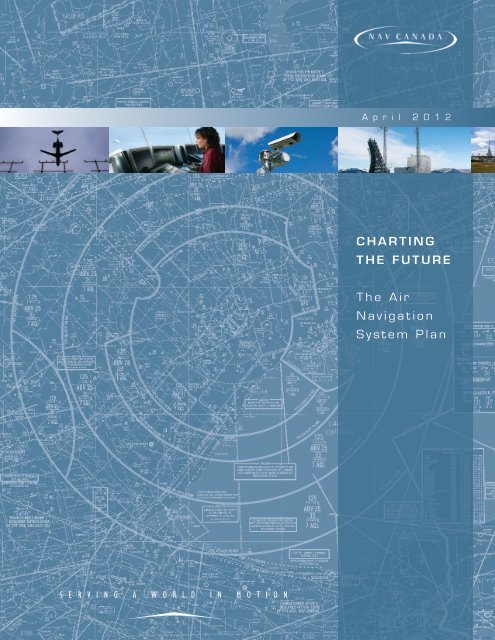
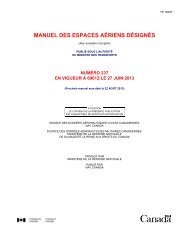
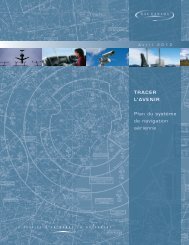

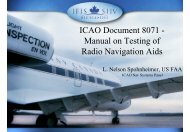
![[ cac ] canadian airport charts - Nav Canada](https://img.yumpu.com/12328212/1/190x252/-cac-canadian-airport-charts-nav-canada.jpg?quality=85)

